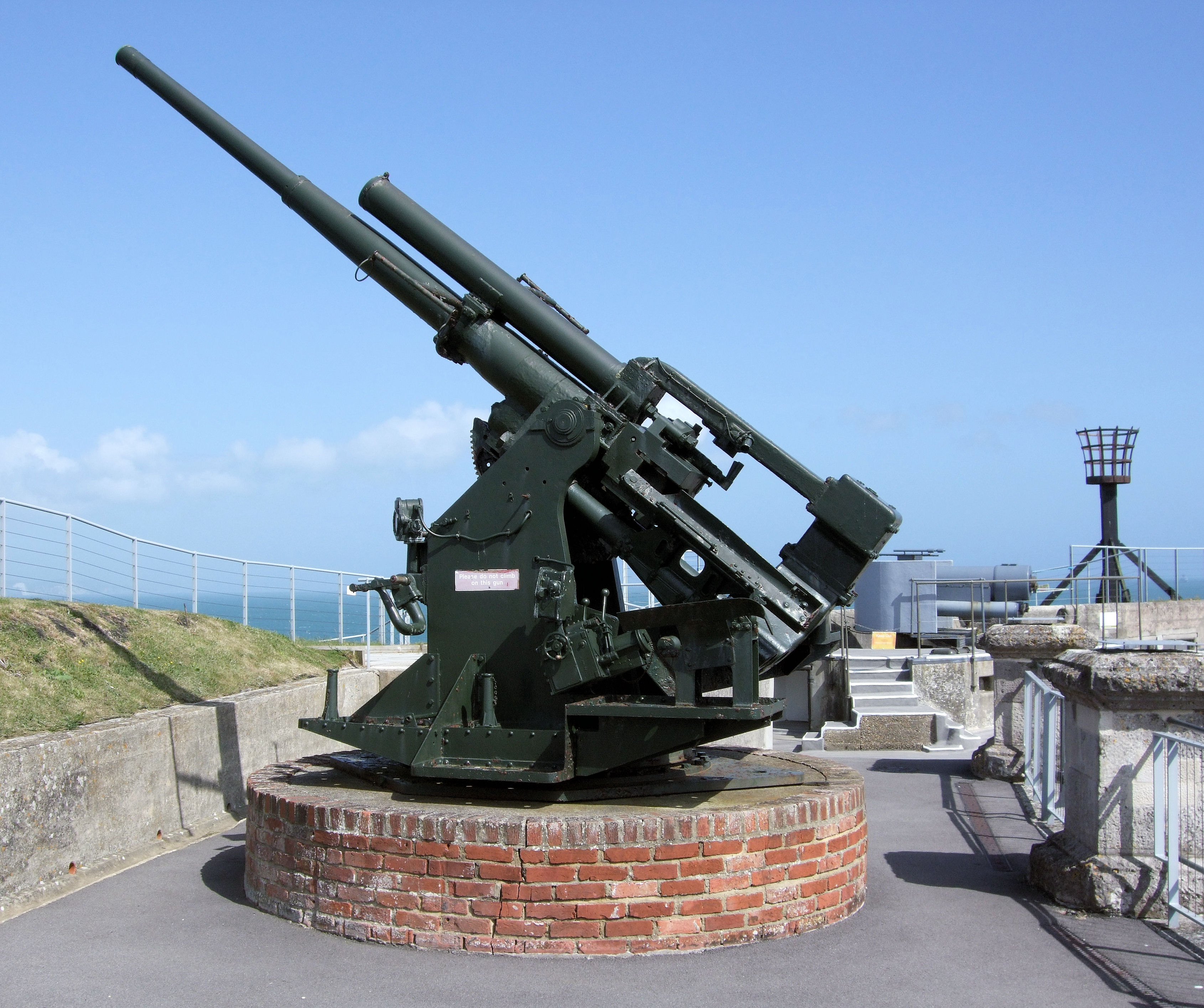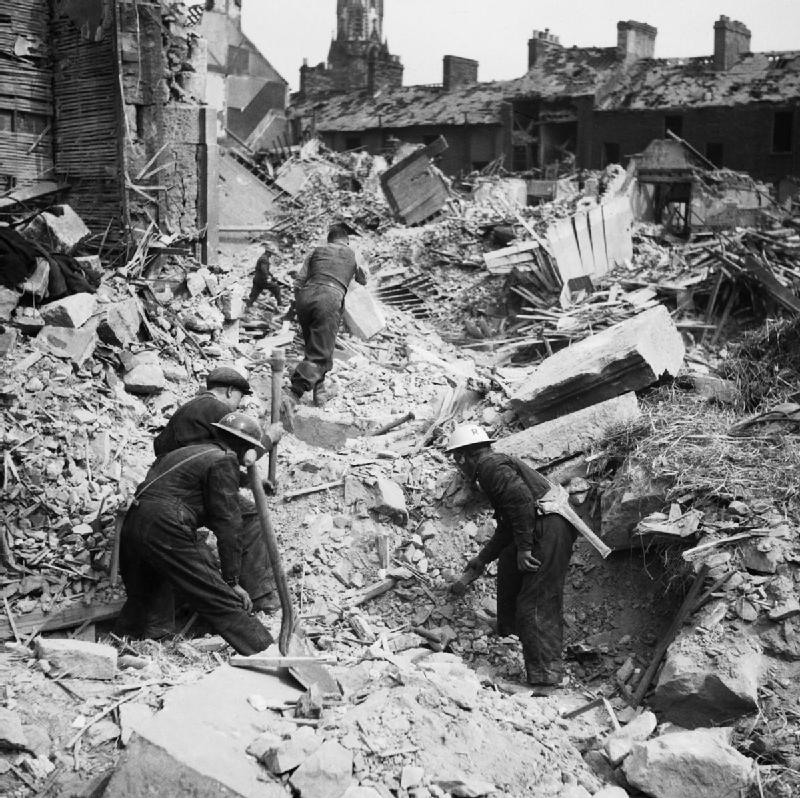|
359th Heavy Anti-Aircraft Battery, Royal Artillery
The 359th Heavy Anti-Aircraft Battery, Royal Artillery (359th HAA Bty) was an air defence unit of the British Army during World War II. After defending the North Midlands during The Blitz, it formed part of Force 122 sent to protect the Falkland Islands against a possible Japanese invasion, where it mounted both heavy (HAA) and light (LAA) anti-aircraft guns in inhospitable conditions. Origin 359th Heavy Anti-Aircraft Battery (359th HAA Bty) was raised in the Royal Artillery (RA) on 21 September 1940 as part of the rapid expansion of Britain's Anti-Aircraft (AA) defences. On 10 December it joined a new 113th HAA Regiment forming at No 3 AA Practice Camp at Tŷ Croes on Anglesey.Frederick, pp. 757, 781.Farndale, Annex M. The Blitz On 10 December, the regiment moved to the Nottingham–Derby Gun Zone, where it came under the operational control of 50th AA Brigade in 2nd AA Division. 359th HAA Battery occupied two gun sites at Derby.113 HAA Rgt War Diary 1940-41, The National Arch ... [...More Info...] [...Related Items...] OR: [Wikipedia] [Google] [Baidu] |
Flag Of The British Army
A flag is a piece of fabric (most often rectangular or quadrilateral) with a distinctive design and colours. It is used as a symbol, a signalling device, or for decoration. The term ''flag'' is also used to refer to the graphic design employed, and flags have evolved into a general tool for rudimentary signalling and identification, especially in environments where communication is challenging (such as the maritime environment, where semaphore is used). Many flags fall into groups of similar designs called flag families. The study of flags is known as "vexillology" from the Latin , meaning "flag" or "banner". National flags are patriotic symbols with widely varied interpretations that often include strong military associations because of their original and ongoing use for that purpose. Flags are also used in messaging, advertising, or for decorative purposes. Some military units are called "flags" after their use of flags. A ''flag'' (Arabic: ) is equivalent to a brigade ... [...More Info...] [...Related Items...] OR: [Wikipedia] [Google] [Baidu] |
The National Archives (United Kingdom)
, type = Non-ministerial department , seal = , nativename = , logo = Logo_of_The_National_Archives_of_the_United_Kingdom.svg , logo_width = 150px , logo_caption = , formed = , preceding1 = , dissolved = , superseding = , jurisdiction = England and Wales, HM Government , headquarters = Kew, Richmond, Greater London TW9 4DU , region_code = GB , coordinates = , employees = 679 , budget = £43.9 million (2009–2010) , minister1_name = Michelle Donelan , minister1_pfo = Secretary of State for Digital, Culture, Media and Sport , minister2_name = TBC , minister2_pfo = Parliamentary Under Secretary of State , chief1_name = Jeff James , chief1_position = Chief Executive and Keeper of the Public Records , chief2_name = , chief2_position = , chief3_name = , chief3_position = , chief4_name = , chief4_position = , chief5_name = , chief5_position = , agency_type = , chief6_name = , chief6_position = , chief7_name = , chief7_position = ... [...More Info...] [...Related Items...] OR: [Wikipedia] [Google] [Baidu] |
War Office
The War Office was a department of the British Government responsible for the administration of the British Army between 1857 and 1964, when its functions were transferred to the new Ministry of Defence (MoD). This article contains text from this source, which is available under th Open Government Licence v3.0 © Crown copyright It was equivalent to the Admiralty, responsible for the Royal Navy (RN), and (much later) the Air Ministry, which oversaw the Royal Air Force (RAF). The name 'War Office' is also given to the former home of the department, located at the junction of Horse Guards Avenue and Whitehall in central London. The landmark building was sold on 1 March 2016 by HM Government for more than £350 million, on a 250 year lease for conversion into a luxury hotel and residential apartments. Prior to 1855, 'War Office' signified the office of the Secretary at War. In the 17th and 18th centuries, a number of independent offices and individuals were re ... [...More Info...] [...Related Items...] OR: [Wikipedia] [Google] [Baidu] |
Woolwich
Woolwich () is a district in southeast London, England, within the Royal Borough of Greenwich. The district's location on the River Thames led to its status as an important naval, military and industrial area; a role that was maintained throughout the 16th to 20th centuries. After several decades of economic hardship and social deprivation, the area now has several large-scale urban renewal projects. Geography Woolwich is situated from Charing Cross. It has a long frontage to the south bank of the Thames river. From the riverside it rises up quickly along the northern slopes of Shooter's Hill towards the common, at and the ancient London–Dover Road, at . The ancient parish of Woolwich, more or less the present-day wards Woolwich Riverside and Woolwich Common, comprises . This included North Woolwich, which is now part of the London Borough of Newham. The ancient parishes of Plumstead and Eltham became part of the civil parish of Woolwich in 1930. Parts of the wards ... [...More Info...] [...Related Items...] OR: [Wikipedia] [Google] [Baidu] |
63rd Anti-Aircraft Brigade (United Kingdom)
The 37th Anti-Aircraft Brigade was an air defence formation of Britain's Territorial Army (TA) formed just before the outbreak of the Second World War. It was engaged in defending the Thames Estuary during the war, and continued to form part of Anti-Aircraft Command in the postwar era. Origin As international tensions rose in the late 1930s, Britain's Anti-Aircraft (AA) defences were strengthened with new Royal Artillery (RA) regiments. 37th AA Brigade was raised on 1 May 1938, with its HQ at Edmonton in North London, to control some of these AA units in the London area. It was commanded by Brigadier Edward William Gravatt Wilson, MC, appointed 29 September 1938, who after he left in 1940 went on to be AA Defence Commander (AADC) Egypt.Frederick, pp. 1048–51. In 1939 37th AA Brigade joined the newly formed 6th AA Division based at Uxbridge, which had responsibility for air defence of the Thames Estuary, Essex and North Kent, and the approaches to London. Order of Battle 193 ... [...More Info...] [...Related Items...] OR: [Wikipedia] [Google] [Baidu] |
GL Mk
GL, Gl, or gl may refer to: Businesses and brands *Air Greenland, IATA airline designator *Germanischer Lloyd, a classification society * GlobalLogic, a Digital Product Engineering Services company Government and military * GreenLeft, a Dutch political party * Green-Libertarian, a North American political philosophy * Gwardia Ludowa, a Polish resistance group during World War II * Grenade launcher, a military weapon Language * Galician language (ISO 639 alpha-2 language code) * Good Luck, in Internet slang * Palatal lateral approximant, a digraph in Italian Miscellaneous media * Girls' love, an anime and manga jargon term for lesbian fiction * Golden Lovers, a Japanese professional wrestling team * ''Good Luck!!'', a 2003 television drama * Green Lantern, any of a number of similarly themed DC Comics characters * ''Guiding Light'', an American soap opera * ''Gurren Lagann'', a 2007 Japanese anime People *G. L. Peiris, Sri Lankan politician and academic *Gary Lightbody, lead s ... [...More Info...] [...Related Items...] OR: [Wikipedia] [Google] [Baidu] |
QF 3
QF may stand for: * Qantas, an airline of Australia (IATA code QF) * Qatar Foundation, a private, chartered, non-profit organization in the state of Qatar * Quality factor, in physics and engineering, a measure of the "quality" of a resonant system * Quick-firing gun, a sort of artillery piece * Quiverfull, a movement of Christians who eschew all forms of birth control * A gun breech that uses metallic cartridges (see British ordnance terms#QF) * Quds Force The Quds Force ( fa, نیروی قدس, niru-ye qods, Jerusalem Force) is one of five branches of Iran's Islamic Revolutionary Guard Corps (IRGC) specializing in unconventional warfare and military intelligence operations. U.S. Army's Iraq War ... an expeditionary warfare unit of IRGC {{disambig fr:QF ... [...More Info...] [...Related Items...] OR: [Wikipedia] [Google] [Baidu] |
Irvine, North Ayrshire
Irvine ( ; sco, Irvin, gd, Irbhinn, IPA: �iɾʲivɪɲ is an ancient settlement, in medieval times a , and now a new town on the coast of the in North Ayrshire, |
Burrow Head
Burrow Head is the southernmost tip of the Machars peninsula in south-west Scotland. It is located approximately two miles south-west of Isle of Whithorn, Wigtownshire and is the second southernmost point of Scotland (after the Mull of Galloway). St. Ninian's Cave is approximately two miles north-west along the coast. It is an important location for pilgrims who believe that St. Ninian spent some time on retreat there. Burrow Head's location and relative seclusion meant that during the eighteenth century it became associated with smuggling, from and to the Isle of Man (fifteen miles south) and Ireland. In more recent years, Burrow Head became famous as a location for the 1973 thriller film ''The Wicker Man''. Until recently the stumps of the prop used as the wicker man in the film remained visible, but these have been gradually eroded by souvenir hunters. Today much of Burrow Head is occupied by a caravan park Caravan or caravans may refer to: Transport and travel *Carav ... [...More Info...] [...Related Items...] OR: [Wikipedia] [Google] [Baidu] |
12th Anti-Aircraft Division (United Kingdom)
12th Anti-Aircraft Division (12th AA Division) was an air defence formation of the British Army during the early years of the Second World War. It defended Western Scotland and Northern Ireland, including the period of the Clydebank Blitz and Belfast Blitz, but only had a short career. Mobilisation The 12th Anti-Aircraft Division was one of five new divisions created on 1 November 1940 by Anti-Aircraft Command to control the expanding anti-aircraft (AA) defences of the United Kingdom. The division was formed by separating responsibility for Western Scotland (particularly the industrial areas of Clydeside and Ayrshire) and Northern Ireland from the existing 3rd AA Division, which continued to be responsible for the rest of mainland Scotland.Routledge, p. 394; Map 34.Frederick, p. 1047. The divisional headquarters (HQ) was at Glasgow and the General Officer Commanding (GOC), appointed on 15 November 1940, was Major-General Gerald Rickards, promoted from command of 44th AA Brigade ... [...More Info...] [...Related Items...] OR: [Wikipedia] [Google] [Baidu] |
42nd Anti-Aircraft Brigade (United Kingdom)
42nd Anti-Aircraft Brigade was an air defence formation of Britain's Territorial Army (TA). It was responsible for protecting the City of Glasgow and industry along the Firth of Clyde during the Second World War. Mobilisation With the expansion of Britain's Anti-Aircraft (AA) defences during the late 1930s, new formations were created to command the growing number of Royal Artillery (RA) and Royal Engineers (RE) AA gun and searchlight units. 42nd AA Brigade was raised on 1 October 1938 at Glasgow, and formed part of 3rd AA Division, which had been created a month earlier for the air defence of Scotland and Northern Ireland.Frederick, pp. 1050–1. 42 AA Brigade's first commander was Brigadier W.M.M.O'D. Welsh, DSO, MC, appointed 1 October 1938. At the time the brigade was formed, the TA's AA units were in a state of mobilisation because of the Munich crisis, although they were soon stood down. In February 1939 Britain's AA defences came under the control of a new Anti-Aircraft ... [...More Info...] [...Related Items...] OR: [Wikipedia] [Google] [Baidu] |





